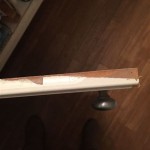Refinish Kitchen Cabinets Without Sanding
Renovating your kitchen can be a daunting task, often involving significant time, effort, and expense. However, a simple and effective way to revitalize your kitchen without a complete overhaul is to refinish your cabinets. While sanding is the traditional approach, it can be a messy and time-consuming process. Fortunately, there are several methods to refinish kitchen cabinets without sanding, offering a more convenient and efficient alternative.
1. Liquid Deglosser: A Chemical Solution
Liquid deglosser is a chemical solution specifically designed to remove the existing finish from cabinets without the need for sanding. This approach offers a quick and efficient way to prepare cabinets for repainting. To effectively use a liquid deglosser, follow these steps:
- Clean the cabinets thoroughly. Remove any dust, grease, or grime with a cleaning solution suitable for kitchen surfaces.
- Apply the deglosser according to the manufacturer’s instructions. Typically, this involves applying the solution to a small section of the cabinet, letting it sit for a specified amount of time, and then wiping it off.
- Repeat the process for the entire cabinet.
- Ensure proper ventilation while working with the deglosser, as it can emit fumes.
- After applying the deglosser, allow the cabinets to dry completely before proceeding with the painting process.
Liquid deglosser effectively prepares the surface for paint by removing the existing finish and creating a rough texture for better adhesion. However, it's important to choose a deglosser specifically designed for kitchen cabinets and follow the manufacturer's instructions carefully to avoid damaging the cabinet surfaces.
2. Paint Primer: A Bonding Agent
A paint primer acts as a bonding agent, creating a smooth and even surface for the new paint to adhere to. Instead of sanding, a primer can be used to cover imperfections and create a durable finish. This method is ideal for cabinets with minor scratches or blemishes that do not require extensive sanding.
- Thoroughly clean the cabinets to remove any dust, grease, or debris.
- Apply the primer with a brush or roller in thin, even coats, ensuring complete coverage.
- Allow the primer to dry completely before applying the paint.
Choosing a primer specifically designed for cabinets ensures optimal adhesion and durability, preventing the paint from chipping or peeling. It's important to note that using a primer may not be as effective as sanding for removing significant imperfections or deep scratches.
3. Painting Techniques: Achieving a Smooth Finish
While sanding is often associated with achieving a smooth paint finish, several painting techniques can help create a flawless look without sanding. Utilizing appropriate tools and techniques can minimize imperfections and create a professional result.
- Use a high-quality paint formulated for cabinets and ensure it's well-mixed before applying.
- Employ small, even strokes when applying the paint, ensuring smooth coverage without leaving brush marks.
- Apply thin coats, allowing each coat to dry completely before applying the next.
- Use a good quality paintbrush with fine bristles for precise application and a smooth finish.
For challenging areas, such as cabinet doors, consider using a spray paint gun for a smooth and even finish. This technique allows for a more consistent application and minimizes the risk of brush marks or uneven coverage. However, proper preparation and practice are crucial for obtaining the desired results.

How To Paint Kitchen Cabinets Without Sanding Sustain My Craft Habit

Can You Paint Kitchen Cabinets Without Sanding

How To Paint Kitchen Cabinets Without Sanding The Budget Decorator

How To Paint Cabinets Without Sanding

How To Paint Cabinets Without Sanding A Fresh Squeezed Life

How To Paint Kitchen Cabinets Without Sanding Sustain My Craft Habit

How To Paint Kitchen Cabinets White Without Sanding Painting Old

Painting Over Oak Cabinets Without Sanding Or Priming Hometalk

Can You Paint Cabinets Without Sanding Trusted Coatings

Paint Kitchen Cabinets Without Sanding Six Simple Steps
Related Posts








